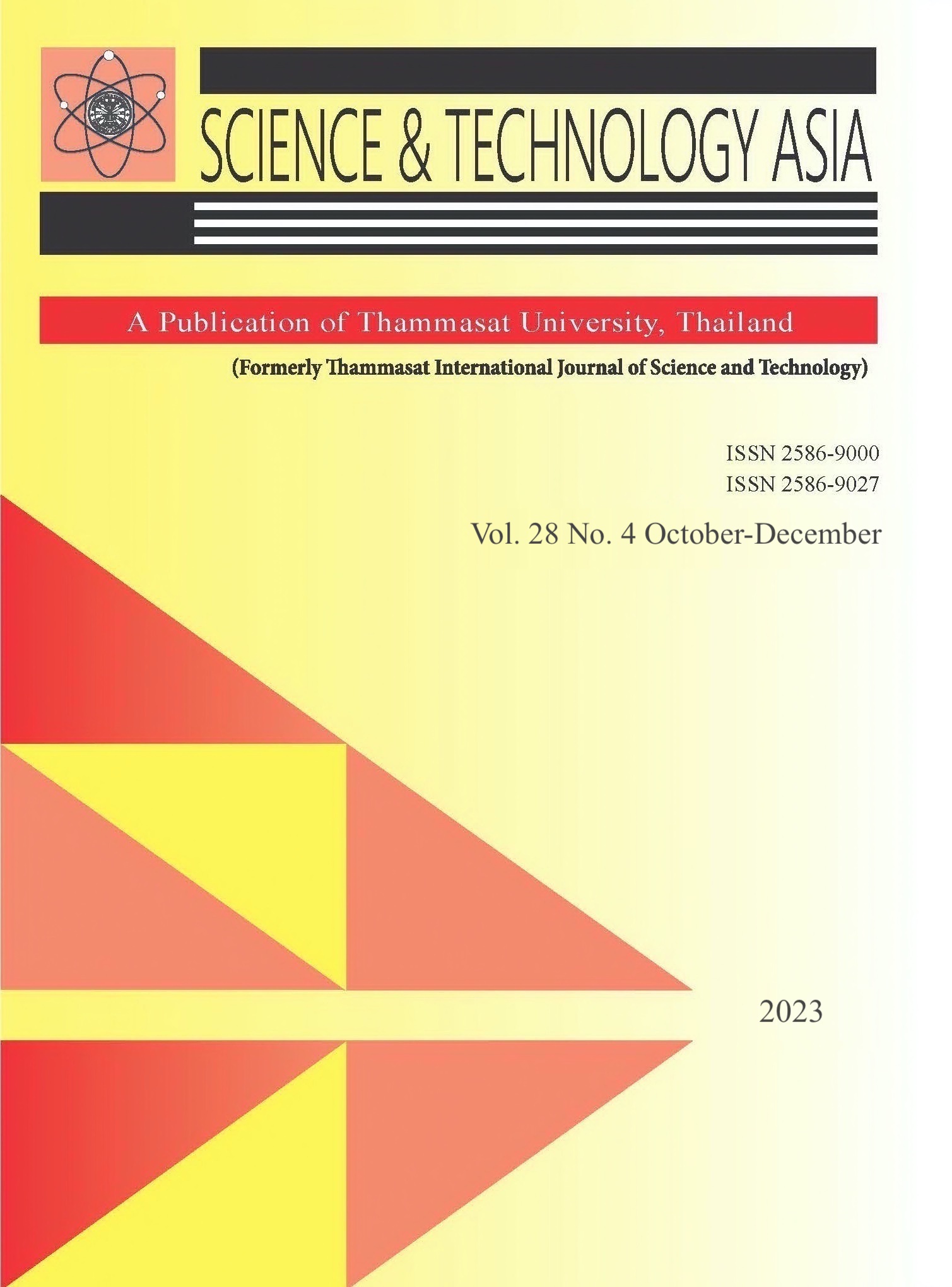Environmental Impact Assessment of LED Lamp Types for Industrial Lighting Purpose
Main Article Content
Abstract
Thailand aims to cut final energy consumption to 30% of the 2010 level by 2037 via the National Energy Efficiency Plan (2018 - 2037). The plan focuses on promoting LED lighting and enhancing energy efficiency in the industrial sector. Thai authorities are working on longterm strategies for effective energy and environmental management. It’s important to avoid using residential LED lamps in industrial facilities to prevent energy wastage and environmental degradation. This study used Life Cycle Assessment (LCA) to evaluate the environmental impact of using the wrong LED lamp type in industrial lighting. It also examined how Thailand's current (2023), and future (2036) electricity mix affects environmental impact. The findings revealed that using residential LED lamps for industrial purposes results in a 25% higher environmental impact during the usage phase. The higher environmental impact during the usage phase is mainly caused by the lower efficiency of residential LED lamps. The sensitivity analysis found that the 2023 electricity mix has a more significant impact on 10 midpoint impact categories than the 2036 mix. Notably, ionizing radiation and water consumption were significantly affected by the 2036 electricity mix. However, at the endpoint level, the 2036 electricity mix had lower environmental impacts compared to the 2023 mix. Choosing the right LED lamp for industrial lighting is crucial to reduce energy waste and limit environmental harm. Furthermore, when planning for future clean energy generation, it's important to factor in the impact of the electricity mix.
Article Details

This work is licensed under a Creative Commons Attribution-NonCommercial-NoDerivatives 4.0 International License.
References
Kresnawan MR, Suryad B. Key Insights About the ASEAN Energy Landscape in 2022. 12950, Jakarta: ASEAN Centre for Energy. Available from: https://aseanenergy.sharepoint.com/
UNEP. Global Environment Facility. The Rapid Transition to Energy Efficient Lighting: an Integrated Policy Approach. France: UNEP/gef; 2013. Report no.: EN0313
UNEP. Brighten Up! Making the switch to efficient lighting. Available from: https://www.unep.org/news-andstories/story/brighten-making-switchefficient-lighting
IEA. Regional focus: Southeast Asia –electricity market analysis. 2020. Available from: https://www.iea.org/reports/electricitymarket-report-december-2020/2020-regional-focus-southeast-asia
Nieuwlaar E. Life Cycle Assessment and Energy Systems. Reference Module in Earth Systems and Environmental Sciences. 2013;7:647-54.
Electricity Generating Authority of Thailand (EGAT). Demand side management. 2018. Available from: https://www.egat.co.th/en/sustainabledevelopment/demand-side-management
LED Inside. Strategic Analysis of the LED Lighting Market in Southeast Asia. The Frost & Sullivan Story; 2016. Report no.: 9AAF-00-26-00-00.
U.S. DOE (2017) Adoption of Light-Emitting Diodes in Common Lighting Applications, Washington: Solid-State Lighting Program-U.S. Department of Energy; 2017. Report no.: 20585-0121.
Mehta R, Dixit G. Consumer decision making styles in developed and developing markets: A cross-country comparison. Journal of Retailing and Consumer Services. 2016;33:202-8.
Casamayor JL, Su D. Integration of ecodesign tools into the development of ecolighting products. Journal of Cleaner Production. 2013;47:32-42.
Dillon HE, Ross C, Dzombak R. Environmental and energy improvements of LED lamps over time: A comparative life cycle assessment. LEUKOS- The Journal of the Illuminating Engineering Society. 2019;16(3):229-37.
Ministry of Energy. Thailand Power Development Plan 2015-2036. 2015 Available from: https://www.egat.co.th/en/images/about/e
gat/PDP2015_Eng.pdf
Principi P, Fioretti R. A comparative life cycle assessment of luminaires for general lighting for the office – compact fluorescent (CFL) vs light emitting diode (LED) – a case study. Journal of Cleaner Production, 2014;83:93-107.
Dale AT, Bilec M, Marriott J, Hartley D, Jurgens C, Zatcoff E. Preliminary comparative life cycle impacts of Streetlight Technology. Journal of Infrastructure Systems. 2011;17(4):193-9.
Hadi SA, Kaabi MR, Ali MO, Arafat HA. Comparative life cycle assessment (LCA) of streetlight technologies for minor roads in United Arab Emirates. Energy for Sustainable Development, 2013;17:438-50.
Tähkämö L, Bazzana M, Ravel P, Grannec F, Martinsons C, Zissis G. Life cycle assessment of light-emitting diode downlight luminaire-a case study. The International Journal of Life Cycle Assessment, 2013;18(5):1009-18.
Chunark P, Promjiraprawat K, Limmeechokchai B. Impacts of CO2 reduction target and taxation on Thailand's power system planning towards 2030. Energy Procedia, 2014;52:85-92.
Pongsoi P, Wongwises S. A review on Nuclear Power Plant Scenario in Thailand. Renewable and Sustainable Energy Reviews, 2013;24(5):86-92.
CBRE. Insights & Research. Available from: https://www.cbre.co.th/insights
Casamayor JL, Su D. Integration of ecodesign tools into the development of ecolighting products. Journal of Cleaner Production, 2013;47:32-42.
Frischknecht R, Jungbluth N, Althaus H, et al. The ecoinvent Database: Overview and Methodological Framework. The International Journal of Life Cycle Assessment, 2004;10:3-9.
Santoyo-Castelazo, E., Gujba, H. and Azapagic, A. 2011. Life cycle assessment of electricity generation in Mexico. Energy. 36(3): 1488–1499.
Canaj K, Mehmeti A, Cantore V, Todorović M. LCA of tomato greenhouse production using spatially differentiated life cycle impact assessment indicators: An albanian case study. Environmental Science and Pollution Research, 2019;27(7):6960-70.
Turconi R, Boldrin A, Astrup T. Life cycle assessment (LCA) of electricity generation technologies: Overview, comparability, and limitations. Renewable and Sustainable Energy Reviews, 2013;28:555-65.
Borrion AL, Khraisheh M, Benyahia F. Environmental life cycle impact assessment of gas-to-liquid processes. Proceedings of the 3rd Gas Processing Symposium, 2012:71-7.
Yi S, Abbasi K, Hussain K, Albaker A, Alvarado R. 2023. Environmental concerns in the United States: Can renewable energy, fossil fuel energy, and natural resource depletion help? Gondwana Research.
Atilgan B, Azapagic A. Life cycle environmental impacts of electricity from fossil fuels in Turkey. Journal of Cleaner Production, 2015;106:555-64.
Violi A, Cormier S, Gullett B, et al. Combustion by-products and their health effects: Summary of the 16th international congress. Fuel (Lond). January 1, 2021;283:118-562.
Chirarattananon S, Mettanan V, Taweekun J, Hien VD, Rakwamsuk P. 2004. The Joint International Conference on “Sustainable Energy and Environment (SEE)”. In: Development of a Building Energy Code for New Buildings in Thailand. 5th ed. Hua Hin.
Electro-Matic. How factory lighting affects manufacturing productivity. Available from: https://blog.visual.electromatic.com/how-factory-lighting-affectsmanufacturing-productivity
Limmeechokchai B, Suksuntornsiri P. Assessment of cleaner electricity generation technologies for NET CO2 mitigation in Thailand. Renewable and Sustainable Energy Reviews, 2007;11(2):315-30.


